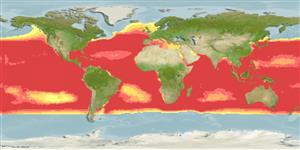Classificação / Names
Common names from other countries
Referência principal
Tamanho / Peso / Idade
Max length : 110 cm FL macho/indeterminado; (Ref. 89423); common length : 80.0 cm FL macho/indeterminado; (Ref. 168); Peso máx. publicado: 34.5 kg (Ref. 168); Idade máx. registada: 12 anos (Ref. 168)
Length at first maturity
Lm 40.0, range 40 - 45 cm
Ambiente
; marinhas; oceanódromo; intervalo de profundidade 0 - 260 m (Ref. 9340), usually 0 - ? m (Ref. 55287)
Clima / Intervalo
Tropical; 15°C - 30°C (Ref. 168), preferred 27°C (Ref. 107945); 63°N - 47°S, 180°W - 180°E
Distribuição
Cosmopolitan in tropical and warm-temperate waters. Not found in the Black Sea. Highly migratory species, Annex I of the 1982 Convention on the Law of the Sea (Ref. 26139).
Países | Áreas FAO | Ecossistemas | Ocorrências | Introduções
Descrição breve
Espinhos dorsais (total): 14 - 16; Raios dorsais moles (total): 14-15; Espinhos anais 0; Raios anais moles: 14 - 15; Vértebras: 41. Interpelvic process small and bifid. Body without scales except for the corselet and the lateral line. Swim bladder absent. The back is dark purplish blue, lower sides and belly silvery, with 4 to six very conspicuous longitudinal dark bands which in live specimens may appear as continuous lines of dark blotches.
Categoria na Lista Vermelha da IUCN (Ref. 115185)
Ameaça para o homem
Reports of ciguatera poisoning (Ref. 4690)
Utilização humana
Pescarias: altamente comercial; peixe desportivo: sim
Ferramentas
Relatórios especiais
Descarregue XML
Fontes da internet
Estimates of some properties based on models
Phylogenetic diversity index
PD50 = 1.0000 many relatives (e.g. carps) 0.5 - 2.0 few relatives (e.g. lungfishes)
Nível Trófico
4.4 ±0.5 se; Based on diet studies.
Resiliência
Médio, tempo mínimo de duplicação da população 1,4 - 4,4 anos (K=0.3-0.5; tm=2-3; tmax=12; Fec=80,000)
Vulnerabilidade
Moderate vulnerability (40 of 100)
Categoria de preço
